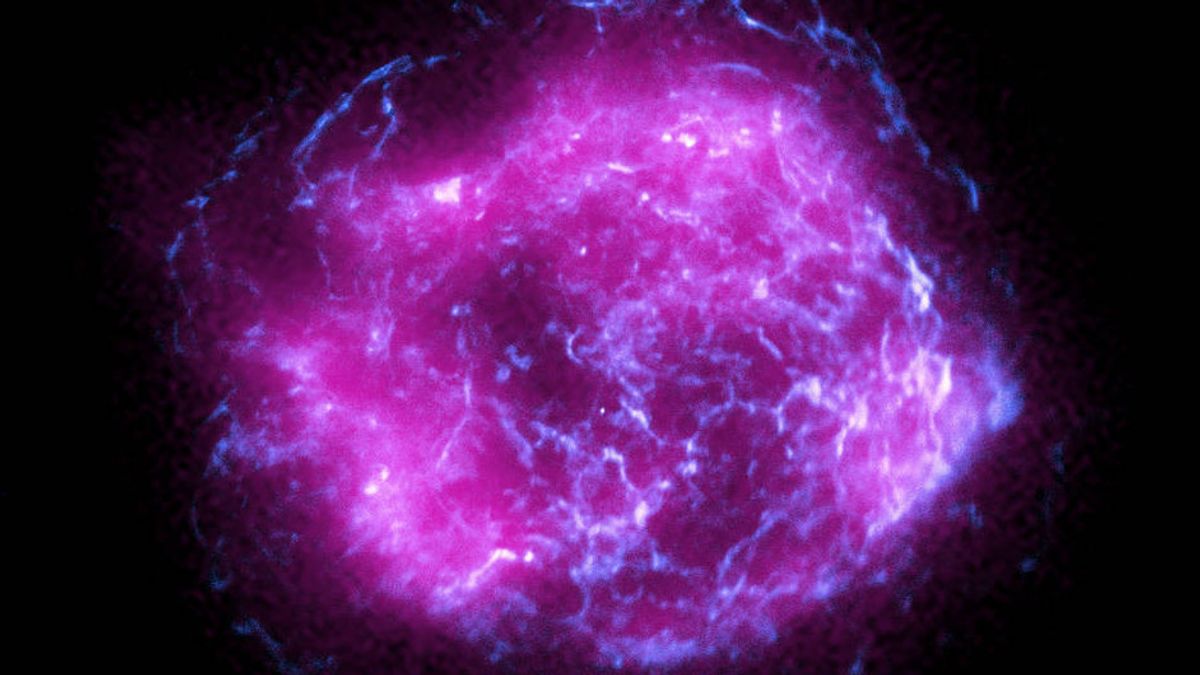JAKARTA - NASA's X-Ray Polarimetry Explorer (IXPE) Imaging Telescope has sent its first image back to Earth. The shots show the remains of a star that exploded in the 17th century.
This space-based observatory will launch on December 9, 2021 from Cape Canaveral, Florida aboard the SpaceX Falcon 9 rocket into low-Earth orbit.
The telescope has spent the past month calibrating its instruments, and is preparing to observe a supernova remnant (SNR) in the constellation Cassiopeia, called Cassiopeia A.
It is the remains of a giant star 11,000 light-years away, first seen in the 17th century, with a shock wave sweeping the gas around it and heating it. The star, produces cosmic ray particles that produce a bright glow in X-ray light.
IXPE joined the Chandra X-ray telescope, one of NASA's great space observatories, launched in 1999, to study various aspects of the X-ray spectrum.
A joint effort between NASA and the Italian Space Agency, IXPE is the first space observatory dedicated to studying the polarization of X-rays emanating from objects such as exploding stars and black holes - this is the orientation of light as it moves.
The new image, released by NASA on Valentine's Day, has IXPE data displayed as magenta balls, overlaid with data from Chandra, shown in blue.
The saturation of the magenta color corresponds to the intensity of the X-ray light observed by IXPE, and the blue color indicates the high-energy X-ray data.
Chandra and IXPE, with different types of detectors, capture varying degrees of angular resolution, or sharpness - giving astronomers and astrophysicists a greater level of detail, to further explore this unusual phenomenon.
After Chandra's launch in 1999, its first image was also of Cassiopeia A, one of the brightest X-ray objects in the constellation Cassiopeia.
Images taken by Chandra reveal that there is a compact object at the center of the supernova remnant - possibly a black hole or a neutron star.
These objects, along with bright clouds of gas and dust, are remnants of massive stars that have reached the end of their lives.
Also known as Cas A, the massive star that shed its outer layer, forming an X-ray cloud, self-exploded more than 14,000 years ago, but its light did not reach Earth until about 350 years ago, as it is 11,090 light-years away.
Supernovae are charged with magnetic energy and accelerate particles to near the speed of light, making them a laboratory for studying the extreme physics of outer space.
"The IXPE image of Cassiopeia A is as historic as the Chandra image of the same supernova remnant," said Martin C. Weisskopf, IXPE principal investigator based at NASA's Marshall Space Flight Center in Huntsville, Alabama, as quoted by Dailymail.
"This demonstrates the potential of IXPE to obtain new, never-before-seen information about Cassiopeia A, which is being analyzed now," added Weisskopf.
The key measurement the scientists will take with the IXPE is called polarization, a way to see how X-ray light is oriented as it travels through space.
Polarization of light contains clues about the environment in which the light originates. The IXPE instrument also measures the energy, time of arrival, and position of X-rays in the sky from cosmic sources.
"The IXPE image of Cassiopeia A is the bellissima," said Paolo Soffitta, principal Italian researcher for IXPE at the National Institute of Astrophysics (INAF) in Rome.
"We hope to analyze the polarimetric data to learn more about this supernova remnant," the researchers added.
"Measuring the polarization of X-rays is not easy," says Weisskopf. “You have to collect a lot of light, and the unpolarized light acts like background noise. It takes a while to detect a polarized signal."
The data IXPE collected from Cassiopeia A, will allow scientists to see how polarization varies across supernova remnants.
It is about 10 light-years in diameter, which is more than twice the distance between Earth and our nearest stellar neighbor, Proxima Centauri.
The researchers are currently working with the data to create the first X-ray polarization maps of the object. This will reveal new clues about how X-rays are produced in Cassiopeia A.
"IXPE's future polarizing images should reveal the mechanisms at the heart of this famous cosmic accelerator," said Roger Romani, IXPE researcher at Stanford University.
“To fill in some of those details, we have developed a way to make IXPE measurements more precise using machine learning techniques. We're looking forward to what we'll find when we analyze all the data."
The English, Chinese, Japanese, Arabic, and French versions are automatically generated by the AI. So there may still be inaccuracies in translating, please always see Indonesian as our main language. (system supported by DigitalSiber.id)













